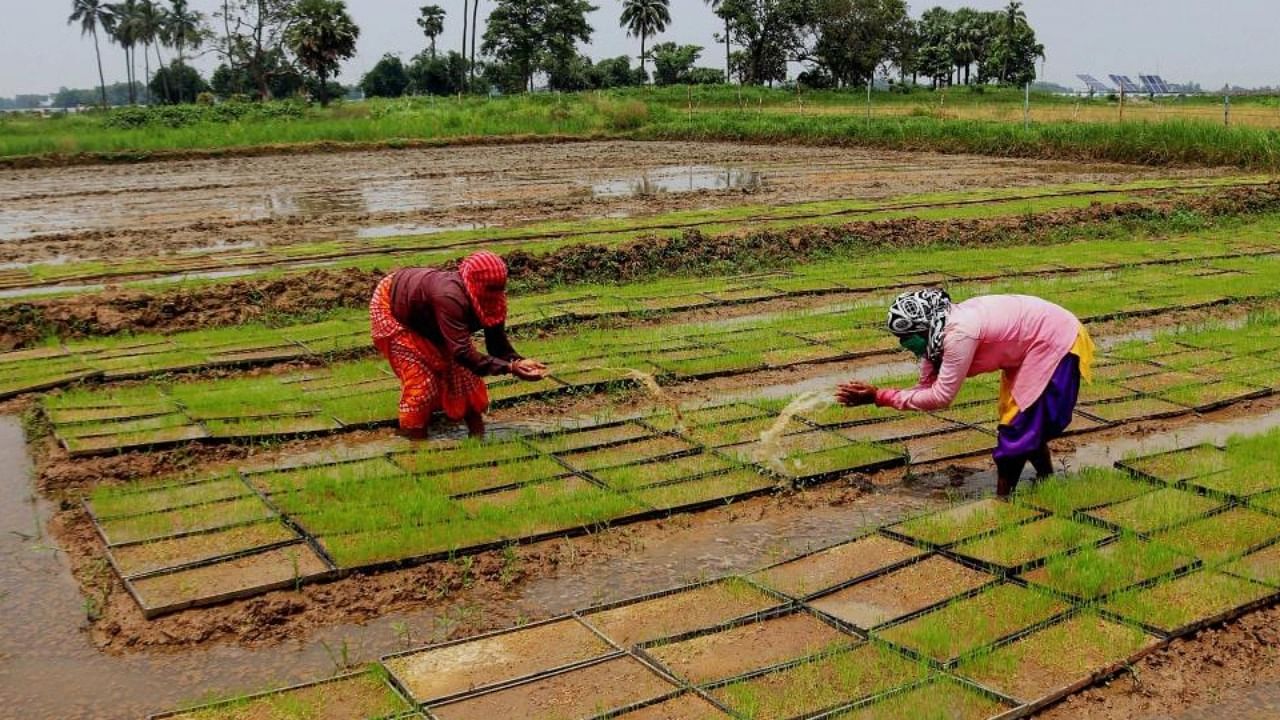
For two years, Manjunath Padiki, a communications professional, scouted for suitable land around Bengaluru to take up farming. This was in 2008 and despite his best efforts, farm land was elusive.
Karnataka’s law did not allow him and his ilk to buy agricultural land, because he was a non-agriculturist.
Padiki’s next option was to go to the neighbouring Tamil Nadu, where land laws are liberal. In 2011, he bought himself over seven acres of land in Denkanikottai, a semi-urban town about 30 km away from Hosur close to the Karnataka border, where he grows millet and is toying with the idea of planting fruits.
In June this year, Karnataka took a big policy decision that allows people like Padiki - anyone, in fact - to purchase and own farmlands.
In July, the B S Yediyurappa administration promulgated an ordinance to amend the Karnataka Land Reforms Act, 1961, removing almost all restrictions on buying farm lands.
This has raised genuine concerns and caution bells have been rung.
The ordinance repealed Section 79(A) that set a limit of non-agricultural income at Rs 25 lakh to buy agricultural land and Section 79(B) that barred non-agriculturists from purchasing agricultural lands. Also, Section 63 has been amended to raise the cap on ownership of farm land.
Prior to the amendment, the ceiling on owning farm lands for a person (or a family of four) was ten units, whereas a family with more than five members could hold 20 units (one unit is 5.4 acres). In other words, the ceiling for a family of four was 54 acres and for a larger family, it was 108 acres.
The amendment has doubled the ceiling, making it 20 units (108 acres) for a person or a family of four, and 40 units (216 acres) for a larger family. Comparatively, this is higher when compared with Kerala (42 acres for a family of 10), Tamil Nadu (59.95 acres) and Andhra Pradesh (54 acres).
These curbs on land ownership were introduced way back in 1974 by the D Devaraj Urs government under the revolutionary ‘land to the tiller’ policy.
The government has justified the removal of restrictions on several fronts, one of them being that many Indian states had done away with such restrictions.
Liberalising agricultural land holdings will certainly have consequences in Karnataka, going by the experiences of its neighbours it held as an example.
In Andhra Pradesh, the absence of a law regulating agricultural land ownership has resulted in lands being used for non-agricultural purposes going up significantly. Between 2008-09 and 2018-19, non-agricultural land use went up from 18.33 lakh hectares to 20.58 lakh hectares, while the net sown area went down from 67.26 lakh hectares to 60.49 lakh hectares.
Commodification of agricultural land, which Karnataka’s decision is expected to usher in, is said to have become rampant in Andhra Pradesh where people buy tracts not for cultivation, but for non-farming, real estate purposes.
“Non-agriculturists formed about 75% of the agri land purchasers in AP between 2010 and 2016, whereas they constituted only about 50% during the same period in Maharashtra where there are curbs,” says economist Dr Ch Shankar Rao, who studied the variation in the prices of agricultural land in villages of the free-market Andhra Pradesh and Maharashtra.
“The lack of regulations resulted in a surge of rich non-farmers entering AP’s land market buying agri-lands mostly for speculative trading. This has resulted in skyrocketing of the unit price of farmland and created an inequality in land holdings where genuine small farmers are alienated from land purchases. The land bought by the rich is kept fallow which is a big loss to agri production,” Rao says.
Tamil Nadu, too, has faced the brunt of leaving the ownership of agricultural land open. The maximum extent of land that can be purchased is 59.95 acres and it can be converted into non-agricultural land provided that no agricultural activity has been carried out during the last 10 years.
“The lack of restrictions has led to a lot of fertile land being used for purposes other than farming,” Tamil Nadu All Farmers Organisations Committee president PR Pandian says. “Acres and acres of fertile land were acquired by companies that wanted to explore methane and hydrocarbon in the Cauvery delta region.”
The Tamil Nadu Land Reforms (Fixation of Ceiling on Land) Act 1961 was enacted with a view to reduce the disparity in the ownership of the agricultural land and concentration of such land with certain persons and to distribute such land among the landless poor. “There may be restrictions, but they are just on paper,” Pandian says, referring to land being bought by people and sold to companies. “The government turns a blind eye because it gets revenue from registration of land and so on.”
Restrictions bypassed
In Kerala, anyone can buy agricultural land as existing restrictions are being bypassed. The maximum land an individual can own is 15 acres, which can be skirted by forming a partnership or trust. But in God’s Own Country, the major issue pertains to protection of wetlands.
The Kerala Conservation of Paddy Land and Wetland Act in 2008 prohibited filling of wetland and agricultural land. It was an initiative of the then left front government led by V S Achuthanandan in the wake of massive filling of wetlands. The law warranted a jail term of six months to 2 years for illegal reclamation.
In 2015, the law was amended by the Congress government legalising wetlands filled before 2008 for a fee. This triggered widespread allegations of helping the real estate lobbies. Over 93,000 applications for regularising wetland conversions were then received, which reflected the massive wetland filling going on in Kerala. This amendment was scrapped in 2016. But in 2018, another amendment was brought in to reclaim paddy fields for major public projects and also regularise illegalities for a higher fee.
All these are warning signs for Karnataka. In any case, the restrictions that were in place since 1974 seem to have had little impact on preventing misuse. In 45 years, authorities registered 83,969 cases covering 1.77 lakh acres of farmland that were acquired or purchased in violation of the law. Worse, the government managed to win only 11% of cases through litigation. Now that the ordinance will have retrospective effect, all cases pending for adjudication will be withdrawn.
“If action cannot be taken, what is the need for such legislation? The provisions only provided an opportunity for assistant commissioners and tahsildars to mint money,” Revenue Minister R Ashoka told DH. “If past governments had acted, at least 1.5 lakh acres of such land should have been forfeited. Nothing was done.”
Even the High Court took note of problems faced by litigants of these cases in getting Khata, Podi and other works done.
The state government has argued that removal of restrictions will allow non-agriculturists to take up farming. “Many agriculture graduates want to cultivate in rural areas. The changes will provide an opportunity for them (to purchase land),” Ashoka said, adding that the move will also bring investments and technology into the agriculture sector.
But wary of how this might play out, the Agriculture Department has asked the government to make sure that only those lands that are unfit or unused for farming should be allowed for purchase. “If the land is not used for agriculture or other activities within three years, then such land should be recovered by the government,” the department said in an internal opinion before the ordinance was promulgated.
Facing flak from all quarters, the government decided to retain some form of regulation. While originally the government proposed repealing Section 80, which prohibited transfer of land to non-agriculturists, the ordinance has retained this with an amendment. The ordinance specifies that Class-A irrigated land (irrigated with water from a dam) can be used only for agricultural purposes. The ordinance has also inserted a new Section 80 (A) which states that none of the relaxations allowed under the Act apply to lands given under the Karnataka SC and ST (Prohibition of Transfer of Certain Lands), Act, 1978.
Amidst apprehensions the amendments will lead to farmers mortgaging land and getting into debt, the ordinance states that mortgage of agricultural land will be permitted only to government institutions, companies and cooperative societies.
But Leader of the Opposition Siddaramaiah is not convinced. He is doggedly pursuing this issue by drumming up support to get the government to drop the ordinance. “This will destroy the farming community. Farmers will have to stand at the doors of corporates. They'll sell their land and real estate will come into the picture. What’ll happen to food production,” he asked.
The Congress leader has now written to Prime Minister Narendra Modi against the ordinance. “The land reforms of 1961 and 1974 enabled marginalised sections, Dalits and other backward classes people to be the owner of the land. It broke the shackles of poverty and bonded labour, and liberated millions of peasants,” he stated in his letter to Modi, adding that the ordinance would make farmers “vulnerable” again.
Farmers groups are up in arms against the government’s decision. "The move that will make it easier for corporates to take over agriculture. This will leave many small farmers landless and will force them to work as labourers in big cities," farmer leader Kuruburu Shanthakumar said, adding that the government's move was clearly prompted by vested interests.
However, there are voices supporting the move. Take Arunachala K, a non-agriculturist who managed to buy agricultural land in Sagara, Shivamogga some 12 years ago. “There was a provision in the law that allowed the assistant commissioner to allow non-agriculturists to be sold farm lands. It took me six months and a lot of running around to do,” he says. “When a farmer’s son can aspire to become a doctor or an engineer, why can’t a doctor or an engineer’s son aspire to become a farmer?”
However, there are voices supporting the move. Take Arunachala K, a non-agriculturist who managed to buy agricultural land in Sagara, Shivamogga some 12 years ago. “There was a provision in the law that allowed the assistant commissioner to allow non-agriculturists to be sold farm lands. It took me six months and a lot of running around to do,” he says. “When a farmer’s son can aspire to become a doctor or an engineer, why can’t a doctor or an engineer’s son aspire to become a farmer?”
Even Padiki, who was forced to buy land in Tamil Nadu, is now considering acquiring farm land in Karnataka. “It’s a level-playing field. People have been buying farm lands by arm-twisting. Now, even I can buy land.”
Based on his farming experience at Denkanikottai, Padiki notes farming is no longer a family affair. “We’re headed for a crisis and legally or illegally, it will become corporatised. I have seen aged farmers feel helpless - they don’t want to do farming anymore because their children are into some other profession and they can’t even sell the land. If I can’t farm anymore, I should be able to sell the land,” he says.
(With inputs from Arjun Raghunath, Prasad Nichenametla, E T B Sivapriyan)
